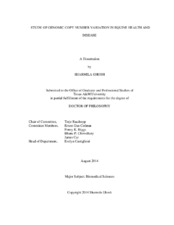| dc.description.abstract | This is a study of copy number variations (CNVs) in the horse genome to gain knowledge about the role of CNVs in equine biology, and their contribution to complex diseases and disorders.
We constructed a 400K whole-genome tiling array and applied it for the discovery of CNVs in 38 normal horses of 16 diverse breeds, and the Przewalski horse. Altogether, 258 CNV regions (CNVRs) were identified across all autosomes, chrX, and chrUn. The CNVRs comprised 1.3% of the horse genome with chr12 being most enriched. American Miniature Horses had the highest and American Quarter Horses the lowest number of CNVs in relation to Thoroughbred references. The Przewalski horse was similar to native ponies and draft breeds. About 20% of CNVRs were intergenic, while 80% involved 750 annotated genes with molecular functions predominantly in sensory perception, immunity, and reproduction.
The findings were integrated with previous CNV studies in the horse to generate a composite genome-wide dataset of 1476 CNVRs. Of these, 301 CNVRs were shared between studies, while 1174 were novel and require further validation. Integrated data revealed that only 41 out of over 400 breeds of the domestic horse have been analyzed for CNVs, whereas this study added 11 new breeds.
The composite CNV dataset served as a foundation for the discovery of variants contributing to Recurrent Airway Obstruction (RAO) and XY disorders of sexual development (DSDs), such as cryptorchidism and XY sex reversal. In 16 RAO affected horses 363 CNVRs were identified, of which 31 were novel and not found in healthy horses. A deletion in SPI2 and SERPINA1 was studied in detail because the genes are involved in respiratory diseases in human. In horses with XY DSDs, over 50 novel CNVRs were identified including deletions of functional interest in the pseudoautosomal region and the ATRX gene. A potentially causative homozygous deletion in chr29 disrupting AKR1C genes with functions in sex hormone metabolism was shared between a cryptorchid and two sex reversal horses.
The findings effectively improved the knowledge about CNVs in horses, in health and disease, and generated resources for future studies. | en |


